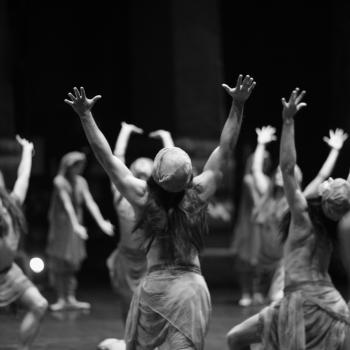Connor Wood
In the bloody and confusing years following September 11th, 2001, a group of scientists and intellectuals led by biologist Richard Dawkins and philosopher Daniel Dennett began loudly calling for less tolerance of religion. Secular-minded popular intellectuals have been criticizing religion since the Roman atheist Lucretius wrote De Rerum Natura, but this was a new level of indignation. These writers, who were quickly dubbed the New Atheists, argued that religions’ nonsensical beliefs – immaterial beings, Heaven, answered prayer, and so forth – led far too easily to violence, intolerance, and bigotry. Therefore religious belief had to go! This may seem like a decent hypothesis, at least at first glance. But recently a trio of psychologists did some empirical work and came to a different conclusion: it’s not religious faith that drives violence and intolerance. It’s religious practice.
Jeremy Ginges, Ian Hansen, and Ara Norenzayan, psychologists at the New School for Social Research and the University of British Columbia, considered the New Atheists’ claims about religion to constitute an empirically testable hypothesis. Did beliefs in things like rewards in Paradise or eternal damnation for nonbelievers make religious people more likely to sanction violent acts against outsiders? Or, as an increasing body of research suggested, could it be that ritual practice and religious attendance made believers feel more tightly bonded to their religious groups…which in turn made them distrust outsiders?
This may sound like splitting hairs, but it’s an important difference. According to the New Atheist hypothesis, religious beliefs themselves are bad news. Dawkins and his followers sometimes describe them as “mind viruses:” dangerous, self-interested programs that colonize our cognitive hardware, using our minds jump from person to person and reproduce willy-nilly over the face of the planet. To the New Atheists, this kind of parasitic model of religion is the only way to make sense of the apparently outrageous, nonempirical beliefs of religious people. Like any viruses, these beliefs also compete against each other – which impels their hosts (that’s us) to fight one another in a bloody contest to secure total control of the neural landscape.
So that’s Hypothesis One: religion is basically about beliefs, and those beliefs inspire people to act nasty towards folks with different beliefs. Got it? Okay.
Hypothesis Two – tested here by Ginges, Hansen, and Norenzayan – suggests something very different. It begins with the observation that humans are coalitional animals; that is, we appear to be “designed” by evolution to form coalitions, or groups, and to use those groups to further our own aims.* In fact, without strong groups humans are toast. We don’t have big fangs, sharp claws, or the ability to outrun a cheetah. We’re soft, pink, hairless upright apes who can’t see too well and have practically no sense of smell (compared to most of the critters who want to eat us, anyway). Strong social bonds and tight groups are our best – and only – realistic tools for survival. Without them, individual humans are goners. So evolution shaped us to form strong, resilient tribes.
But tribes don’t just happen. Like any complex system, they need input and specific processes to keep them going. An oak tree is an example. That oak in your yard is basically an organized, long-lasting arrangement of hydrogen, carbon, and a few other elements. This arrangement is stable over time only because energy flows into the system: the tree sucks in sunlight, transforms it into energy in its chloroplasts, and uses that energy to power its growth and biological processes. (Yes, this is a radically simplified version of the story.) So it’s not by sheer chance that oak trees are organized and stable. Some really important basic processes make it possible for them to be stable in this way. Cut all the leaves off the tree, and photosynthesis stops. Pretty soon the entire system – the whole pattern – will break down. In a few years (at least here on the East Coast, where summertime air humidity reaches approximately 57,564 percent) all that’ll be left will be wet sawdust on the forest floor, teeming with insects and laced with fungi.
So what is it that keeps human groups – complex arrangements of individuals, relationships, and economic artifacts like tools and houses – from metaphorically disintegrating into dust? The answer, according to a growing chorus of evolutionary researchers, anthropologists, and psychologists, is ritual. Ritual is the coordinated, stereotyped action of human bodies that demonstrates – and inspires – allegiance to a group. By participating in the ritual practices of a group, these researchers argue, you’re communicating that you accept the group’s basic moral framework, that you’re agreeing to behave according to its standards, and – perhaps most importantly – that you promise to be loyal to its members.
So, metaphorically, ritual is the photosynthesis of human groups, right? No. That would be a terrible metaphor. But it is, according to some researchers, one of the basic processes that makes it possible for groups to cohere over time. All complex systems depend on specific mechanisms to keep going, whether it’s a hurricane drawing on warm-air convection or a tree turning sunlight into energy. For human tribes, it’s ritual.†
So back to our original question: is it beliefs or practices that makes religious folks ready to do violence to outsiders? When Ginges, Hansen, and Norenzayan gave surveys to several hundred Palestinians and Jewish Israelis, they found that personal prayer didn’t predict support for suicide bombings against religious enemies. But for both Palestinians and Jews, attendance at religious services did.
For instance, Palestinians who prayed five times a day were no more likely than others to condone violent acts against Israelis. But those who attended mosque regularly gave a very different answer; daily attendees were between two and four more times likely to support violent bombing attacks against Israelis. The same pattern held true for Israelis: Israelis who attended synagogue more often were more supportive of a violent act against Muslims. Israelis who prayed regularly weren’t.
The researchers assumed that personal prayer was a good indicator of belief in the tenets of respondents’ religions. And in fact, those who prayed often were much more likely to report that religion was “very important” in their lives. Attendance at services, however, didn’t predict religious devotion independent of personal prayer. The conclusion? It’s clearly not beliefs, the authors claimed, that drive people to support violence against outsiders. It’s ritual.
Bolstering this conclusion, the authors found that the effect of religious attendance persisted even after controlling for which type of mosque or synagogue respondents attended:
The effect of mosque attendance cannot be attributed solely to propaganda by religious clerics or to recruitment efforts at mosques, as it held even when we controlled for identification with organization carrying out suicide attacks…(and) for support for political Islam.
In other words, young Palestinians weren’t just going to radical mosques, hearing anti-Israeli messages from fiery preachers, and then deciding to support jihad against Israel. It was just going to mosque, period, that had the polarizing effect.
Taking their research efforts further, the authors also examined the results from a massive worldwide study conducted on behalf of the BBC. The survey asked for religious identification, participation, and beliefs, and also asked respondents if they agreed with items such as “I blame people of other religions for much of the trouble in this world.” Participants included Indian Hindus, Russian Orthodox, Israeli Jews, Indonesian Muslims, British Protestants, and Mexican Catholics. As the researchers expected, religious beliefs (as measured implicitly by personal prayer) didn’t predict negative attitudes toward other religious in any of the groups. In fact, among some groups personal prayer negatively predicted outgroup hostility. But across the board, religious attendance strongly predicted mistrust of, and hostility toward, religious outsiders. The strongest effect was among the Orthodox in Russia, but other groups weren’t immune.
So: personal prayer and belief doesn’t seem to inspire mistrust of, or hostility toward, outgroups. But attendance at formal religious services does. The authors of the study think this finding supports their hypothesis that religion increases between-group tension because it’s an especially strong motivator of our innate tribal tendencies. In particular, ritual practice has been used for thousands of years to bond tribes together: singing, dancing, and praying in time with one another makes people feel bonded…but only with each other.
In a way, this study redeems parts of the New Atheists’ critique of religion. Even though it’s not the strange beliefs themselves that make religious groups mistrust one another, the fact remains that more committed religious practitioners seem to be more likely to be suspicious of, and supportive of violence toward, people from other traditions.
Does this mean that religion is as bad as the New Atheists claim after all? That’s a tough claim to back up. In fact, the very same features of religious life – ritual and group practice – are exactly what predict higher personal well-being, better family relationships, and lower suicide rates. Meanwhile, pure religious belief often doesn’t predict better well-being, and in fact spirituality without religiousness often predicts poor mental health.
In a lot of ways, then, religion is a Catch-22. It primes us to be strongly bonded to the people around us, which is one of the single biggest predictors of personal happiness, health, and life satisfaction. We’re evolved to be tribal animals, after all – it makes sense that living in a strong tribe would make us feel warm and fuzzy. But the stronger our tribes get, the more outsiders look like aliens, or like enemies. Ritual per se doesn’t produce this effect, but instead piggybacks on it and intensifies it. The result is that religious people the world over are a bit more likely to be parochial, local-minded, and suspicious of outsiders than their non-religious peers. In its extreme manifestations, this dynamic produces religious wars – such as the 30 Years War that helped kick off the European Enlightenment.
Enlightenment and humanistic values, in contrast, tend to look askance at strong ingroup bonds and ritual, and to preference universalistic values that shatter tribal boundaries. In fact, this post-tribal value system may the knotty root of the religion-science schism; just like religion piggybacks on our tribal tendencies, science historically has piggybacked on our anti-tribal instincts, valorizing a culture-free, objective picture of reality and making many scientists coolly suspicious of ritual, religion, and most tribal identifiers. (When was the last time you saw a famous scientist wearing Denver Broncos facepaint? Never, that’s when.) But this anti-tribal worldview comes with a price, too: secular countries have much higher suicide rates on average, and many of the ills of modern society – alienation, loneliness, frayed social fabric – are good candidates for symptoms of our rejection of small groups.
The solution to this Catch-22, I believe, is to learn as much as we possibly can about religion, ritual, and their place in human life. As our knowledge expands, we might conceivably learn how to use ritual to create strong groups without demonizing outsiders. There may be genuine techniques to make this happen, waiting for us to discover them. We might also learn how to banish chronic loneliness and disaffection from our modern, industrialized societies without retreating into atavistic parochialism or religious wars. Knowledge is power, folks. Let’s start learning.
_________
* I put “designed” in quotes because, of course, evolution itself doesn’t design anything. Anything that looks like design, like the human eye or our tribal propensities, is the product of a long chain of complex but mechanical interactions. For you theistic evolutionists (most American believers in evolution), this doesn’t necessarily mean there’s no guiding influence on, or force within, evolution – although most biologists don’t condone such speculations. It just means that you can’t look to the brute processes of natural selection alone for any such influence. Natural selection proper is mindless.
† If true, this theory – or more accurately, group of related theories – provides a handy explanation for the well-documented fact that conservative religious denominations in the U.S. are doing better than more liberal denominations. Liberal churches and synagogues tend to be light on ritual, and to let congregants themselves decide whether to participate in rituals like baptism, communion, and – as reported recently in the New York Times – even bar mitzvahs. Conservative denominations, on the other hand, tend to present members with a clear black-and-white choice: take part in the rituals, or go find another church. If ritual evolved in human biocultural history to help us forge strong, somatic, ingroup bonds, then it’s not surprising that the religions that demand more ritual are chugging along nicely while their laxer counterparts are creaking into obsolescence.












